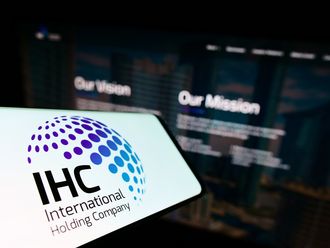Dubai
BrainCo, a technology company that builds artificial intelligence-powered prosthetic hands for amputees, has said it plans to eventually go public to reach as wide an audience as possible.
The company, spun off from an incubator at the Harvard Innovation Labs, has said it is plans to market its prosthetic arm for “social good,” subsidising it with the proceeds from a wearable headband that athletes and schoolchildren alike can use to monitor brain activity.
With a current total of around $30 million raised in seed funding, and with plans to close a Series A round in the coming months, the company’s president told Gulf News that BrainCo had big dreams.
“Our CEO is the most ambitious person I’ve ever met in my life, so I think he would say the goal is absolutely for an initial public offering (IPO),” said Max Newlon, BrainCo USA’s president in an interview at the AI Everything summit in Dubai this week.
The company claims to have made the world’s most affordable AI-powered prosthetic hand: “The level of precision that our users have with this is greater than anything else out there on the market, except for the US government’s quarter-million dollar super-arm,” he said.
BrainCo’s prosthetic arm, which is controlled by the users brain waves, will retail from between $5,000 to $10,000.
Newlon said that the company was able to drive the price down because “this is not going to be our primary profit making product for the company. We’re on a social mission for this aspect of the company.”
According to the senior executive, the firm’s focus is to make prosthetics more affordable and more accessible.
“The way that prosthetics are typically manufactured … if one piece breaks it’s very expensive to get other new pieces. [Another thing] we’re working on, the way that the prosthetic fits the user. This is usually an extensive process.”
So, in order to continue to refine the product and keep its cost low, the company sells a wearable headband that it believes will constitute a greater share of its profits in the future.
The headband measures the electrical activity of your brain, and then uses machine-learning processes to decode thousands of signals coming out of your mind every single second, from which the company can quantify student engagement or attention.
“We pair this with other learning platforms to personalise the student’s experience, because what engages you is going to be different from what engages me,” Newlon said.
Newlon added that by targeting other education platforms as opposed to the schools themselves, the company was able to avoid hitting a wall with a cash-strapped educational system in the US.
Another component, he said, was using the headband to target the fitness space.
“For athletes, there comes a time when mental preparation is perhaps the most important thing they can do,” he said. “So we help them practice and get them in the right state of focus. We can also quantify the impact after their work out of meditation or focus.”
Ultimately, Newlon said, the dream was simply to improve lives.
“The common thread is optimisation and personalisation. If we can create optimised education practices for a teacher, or if we can optimise people’s education platforms, or we can optimise people’s fitness, we’re opening the door to all this data changing people’s lives,” he said.
“The vision we see is integrating the data in to all these applications, and eventually in the very far future, to extend your own capabilities. We’re working with kids with ADHD, and kids with autism, and we’re seeing are there other types of applications for this technology that are more medically-leaning. The possibilities are very broad.”












